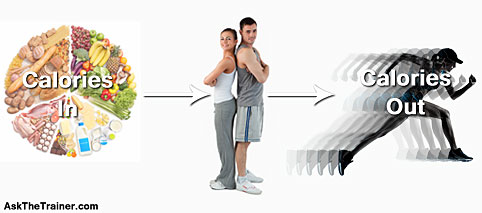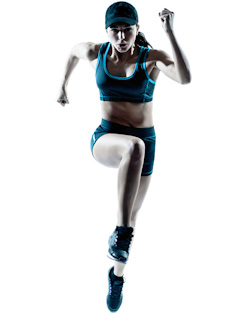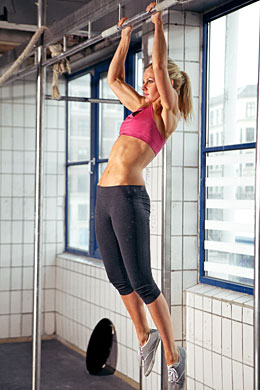- Like
- SHARE
- Digg
- Del
- Tumblr
- VKontakte
- Flattr
- Buffer
- Love This
- Save
- Odnoklassniki
- Meneame
- Blogger
- Amazon
- Yahoo Mail
- Gmail
- AOL
- Newsvine
- HackerNews
- Evernote
- MySpace
- Mail.ru
- Viadeo
- Line
- Comments
- Yummly
- SMS
- Viber
- Telegram
- JOIN
- Skype
- Facebook Messenger
- Kakao
- LiveJournal
- Yammer
- Edgar
- Fintel
- Mix
- Instapaper
- Copy Link
 Improving Your Calorie Burn
Improving Your Calorie Burn
It’s vital that you understand that an essential part of most weight loss is burning more calories than you consume.
It’s no secret that excess calories in the diet will play a key role in the body’s inability to lose weight.
If you consume more calories than what you’re burning off through exercise and your base level of metabolism, you’ll likely gain weight rather than lose it. This is why it’s important to focus on calorie-burning exercises during your workouts, especially if you are trying to lose weight.
Calories In, Calories Out?
 You may have heard the saying “calories in, calories out” with regard to fitness and weight loss. This popular statement seems to imply that it doesn’t matter what types of food you eat as long as you burn the requisite amount of calories. This is an oversimplification in that not all calorie sources are equally healthy for you.
You may have heard the saying “calories in, calories out” with regard to fitness and weight loss. This popular statement seems to imply that it doesn’t matter what types of food you eat as long as you burn the requisite amount of calories. This is an oversimplification in that not all calorie sources are equally healthy for you.
While this is too complicated of a topic to explore deeply in this short article, you need to understand that obsessively counting calories and choosing low-fat/fat-free high chemical processed food will cause you more trouble that it’s worth.
Focus on eating a clean, balanced diet with plenty of nutrients to allow you to exercise energetically and safely. Never ever starve yourself with the aim of creating a calorie deficit. Now that we’ve got that out of the way for now…let’s talk about how to burn more calories in your workouts.
But with so many different types of workout styles and fitness machines out there, how do you know where to start? In this article, we’ll go over some basic and easy-to-follow suggestions that will have you burning more calories during your workouts in no time.
Add More Cardio
 Cardiovascular exercise is defined as any type of aerobic workout which gets the heart pumping faster. Some examples of cardio include running, jogging, biking, using cardio machines such as the treadmill, ARC trainer, elliptical, stair climber or rowing machine, or even going outside to play a game of tennis or basketball.
Cardiovascular exercise is defined as any type of aerobic workout which gets the heart pumping faster. Some examples of cardio include running, jogging, biking, using cardio machines such as the treadmill, ARC trainer, elliptical, stair climber or rowing machine, or even going outside to play a game of tennis or basketball.
Cardio is effective at burning calories because it forces everything in your body to work in overtime. After jogging around the block for 30 minutes, you’ll probably experience an increased heart rate, faster breathing and sweating. All of these actions combined result in a greater amount of calories burned.
Most health and fitness experts recommend a heart rate level somewhere between 60 and 85%. Going beyond this amount could place you at risk for developing health problems. There’s certainly nothing wrong with pushing yourself, but listen to your body and take breaks when necessary.
Hydrate yourself properly. Drink water before, during, and after exercise. Remember that you need to replace the fluids lost through sweating. DO NOT reach for a sugary sports drink to rehydrate. Plain old water works best and will not add extra empty calories. Especially if it’s hot, drink extra water to remain hydrated and prevent heat stroke.
Further Reading:
Try Interval Training
 You’ve probably heard about one of the latest trends in fitness: High Intensity Interval Training, or HIIT. What is it? Basically, you will be performing short bursts of extremely intense exercise to give your metabolism a fierce kick in the pants.
You’ve probably heard about one of the latest trends in fitness: High Intensity Interval Training, or HIIT. What is it? Basically, you will be performing short bursts of extremely intense exercise to give your metabolism a fierce kick in the pants.
In the past, the general idea had been that extended steady cardio is more effective at burning calories than high-intensity interval training (HIIT). However, a recent study performed by Auburn University found that short amounts of HIIT is up to five times more effective at burning calories than cardio. This is a shocking study that should act as an eye opener to anyone trying to lose weight. According to Auburn University Exercise Science Professor Michele Olson.”This particular style of interval training has profound effects even on short-term, post-exercise metabolism. It would take five times the amount of typical cardio exercise, like 20 minutes of very brisk walking, to shed the same number of calories that result from a four-minute (HIIT routine)”.
To perform HIIT safely, you need to work on your FORM first. The exercises will be intense, challenging, and quickly executed, which can lead to poor form resulting in injury. Make sure you understand the exercises and can do them correctly before doing anything as an HIIT routine. HIIT is not the best form of exercise for a beginner. If you’re in doubt or you need help, be sure to get help from a certified personal trainer or take a class at your local gym. The instructor will be able to check out your form and show you modifications if you need them.
Be Smart About Nutrition

Of course, nutrition also plays a key role in burning calories. If you constantly eat fast food meals and other highly processed foods, your metabolism will slow down, making it difficult for your body to burn calories. You can change this around, however, eating a greater amount of “fresh” fruits and vegetables along with whole grains and lean meats.
Meal and snack timing is also important in calorie burning. It may seem like exercising on an empty stomach first thing in the morning would be best, but it’s actually better to eat a small meal with healthy carbohydrate, protein, and fat sources about an hour before exercise. A good choice could be an egg prepared any way you like and a slice of whole grain toast. If your body believes its in starvation mode, it will be less likely to burn calories from fat storage. Moreover, you will have less energy, meaning you will be unable to work out as intensely as you would had you fueled up.
You will also want to eat after exercise to help yourself recover. Focus on protein sources with a small amount of carbs. Greek yogurt (unsweetened) is an excellent recovery food. When you recover properly, you’ll be able to workout vigorously again tomorrow instead of being too tired and wanting a day off.
The Bottom Line
Remember that any exercise/nutrition program needs to be sustainable. You can’t “burn the candle at both ends” by eating too little calories and working out a ton in hopes that you’ll lose weight quickly. Instead of getting lean and toned, you will get burnt out. If you expect super-fast results, you will be disappointed. You have to be patient with yourself and make these changes gradually instead of going to any extreme measures. Your patience will be rewarded as you become much leaner, healthier, and stronger with time.
Did we miss any of your favorite calorie-burning tips? Let us know in the comments below!
About Mae Barraclough
Mae Barraclough, B.S., NASM-CPT, NASM-CES is a certified personal trainer, corrective exercise specialist, and licensed Zumba Instructor. With her passion for health, fitness, and dance, Mae loves learning all she can and sharing her knowledge with others.

